 The first term of the sequence is
The first term of the sequence isIn this section, you will:
A video game company launches an exciting new advertising campaign. They predict the number of online visits to their website, or hits, will double each day. The model they are using shows 2 hits the first day, 4 hits the second day, 8 hits the third day, and so on. See [link].
| Day | 1 | 2 | 3 | 4 | 5 | … |
| Hits | 2 | 4 | 8 | 16 | 32 | … |
If their model continues, how many hits will there be at the end of the month? To answer this question, we’ll first need to know how to determine a list of numbers written in a specific order. In this section, we will explore these kinds of ordered lists.
One way to describe an ordered list of numbers is as a sequence. A sequence is a function whose domain is a subset of the counting numbers. The sequence established by the number of hits on the website is
The ellipsis (…) indicates that the sequence continues indefinitely. Each number in the sequence is called a term. The first five terms of this sequence are 2, 4, 8, 16, and 32.
Listing all of the terms for a sequence can be cumbersome. For example, finding the number of hits on the website at the end of the month would require listing out as many as 31 terms. A more efficient way to determine a specific term is by writing a formula to define the sequence.
One type of formula is an explicit formula, which defines the terms of a sequence using their position in the sequence. Explicit formulas are helpful if we want to find a specific term of a sequence without finding all of the previous terms. We can use the formula to find the
</math> term of the sequence</strong>, where
is any positive number. In our example, each number in the sequence is double the previous number, so we can use powers of 2 to write a formula for the
term.
 The first term of the sequence is
The first term of the sequence is
the second term is
the third term is
and so on. The
term of the sequence can be found by raising 2 to the
power. An explicit formula for a sequence is named by a lower case letter
with the subscript
The explicit formula for this sequence is
Now that we have a formula for the
term of the sequence, we can answer the question posed at the beginning of this section. We were asked to find the number of hits at the end of the month, which we will take to be 31 days. To find the number of hits on the last day of the month, we need to find the 31st term of the sequence. We will substitute 31 for
in the formula.
If the doubling trend continues, the company will get
hits on the last day of the month. That is over 2.1 billion hits! The huge number is probably a little unrealistic because it does not take consumer interest and competition into account. It does, however, give the company a starting point from which to consider business decisions.
Another way to represent the sequence is by using a table. The first five terms of the sequence and the
term of the sequence are shown in [link].
| 1 | 2 | 3 | 4 | 5 | ||
| term of the sequence, | 2 | 4 | 8 | 16 | 32 |
Graphing provides a visual representation of the sequence as a set of distinct points. We can see from the graph in [link] that the number of hits is rising at an exponential rate. This particular sequence forms an exponential function.
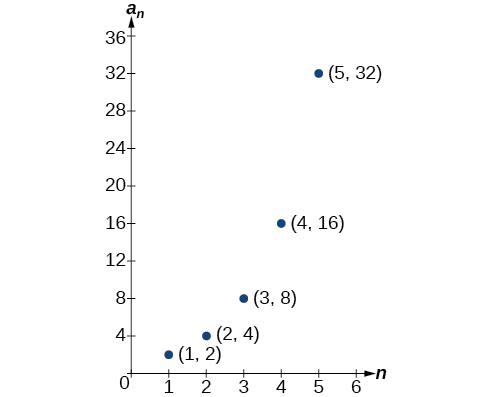
Lastly, we can write this particular sequence as
A sequence that continues indefinitely is called an infinite sequence. The domain of an infinite sequence is the set of counting numbers. If we consider only the first 10 terms of the sequence, we could write
This sequence is called a finite sequence because it does not continue indefinitely.
A sequence is a function whose domain is the set of positive integers. A finite sequence is a sequence whose domain consists of only the first
positive integers. The numbers in a sequence are called terms. The variable
with a number subscript is used to represent the terms in a sequence and to indicate the position of the term in the sequence.
We call
the first term of the sequence,
the second term of the sequence,
the third term of the sequence, and so on. The term
is called the
</math> term of the sequence</strong>, or the general term of the sequence. An explicit formula defines the
term of a sequence using the position of the term. A sequence that continues indefinitely is an infinite sequence.
Does a sequence always have to begin with
*No. In certain problems, it may be useful to define the initial term as
instead of
In these problems, the domain of the function includes 0.*
Given an explicit formula, write the first
terms of a sequence.
into the formula. Begin with
to find the first term,
use
terms.
Write the first five terms of the sequence defined by the explicit formula
Substitute
into the formula. Repeat with values 2 through 5 for
The first five terms are
The sequence values can be listed in a table. A table, such as [link], is a convenient way to input the function into a graphing utility.
| 1 | 2 | 3 | 4 | 5 | |
| 5 | 2 | –1 | –4 | –7 |
A graph can be made from this table of values. From the graph in [link], we can see that this sequence represents a linear function, but notice the graph is not continuous because the domain is over the positive integers only.
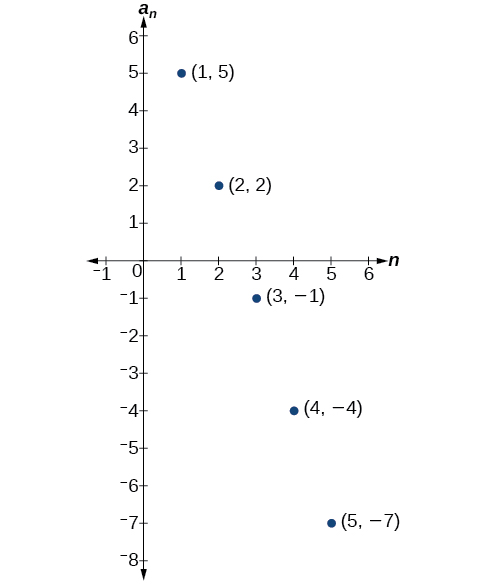
Write the first five terms of the sequence defined by the explicit formula
The first five terms are
Sometimes sequences have terms that are alternate. In fact, the terms may actually alternate in sign. The steps to finding terms of the sequence are the same as if the signs did not alternate. However, the resulting terms will not show increase or decrease as
increases. Let’s take a look at the following sequence.
Notice the first term is greater than the second term, the second term is less than the third term, and the third term is greater than the fourth term. This trend continues forever. Do not rearrange the terms in numerical order to interpret the sequence.
**Given an explicit formula with alternating terms, write the first
terms of a sequence.**
into the formula. Begin with
to find the first term,
The sign of the term is given by the
in the explicit formula.
use
terms.
Write the first five terms of the sequence.
Substitute
and so on in the formula.
The first five terms are
The graph of this function, shown in [link], looks different from the ones we have seen previously in this section because the terms of the sequence alternate between positive and negative values.
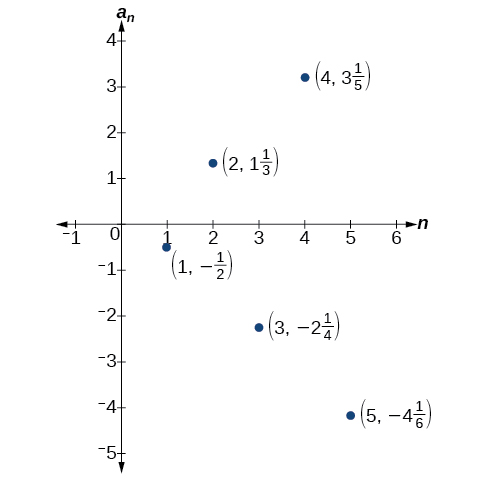
In [link], does the (–1) to the power of
account for the oscillations of signs?
Yes, the power might be
and so on, but any odd powers will result in a negative term, and any even power will result in a positive term.
Write the first five terms of the sequence:
The first five terms are
We’ve learned that sequences are functions whose domain is over the positive integers. This is true for other types of functions, including some piecewise functions. Recall that a piecewise function is a function defined by multiple subsections. A different formula might represent each individual subsection.
**Given an explicit formula for a piecewise function, write the first
terms of a sequence**
applies.
use
in the appropriate formula.
applies.
use
in the appropriate formula.
terms.
Write the first six terms of the sequence.
Substitute
and so on in the appropriate formula. Use
when
is not a multiple of 3. Use
when
is a multiple of 3.
The first six terms are
Every third point on the graph shown in [link] stands out from the two nearby points. This occurs because the sequence was defined by a piecewise function.
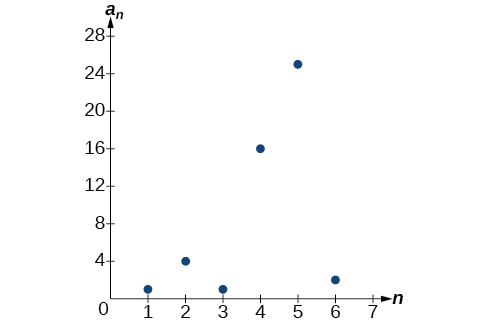
Write the first six terms of the sequence.
The first six terms are
Thus far, we have been given the explicit formula and asked to find a number of terms of the sequence. Sometimes, the explicit formula for the
term of a sequence is not given. Instead, we are given several terms from the sequence. When this happens, we can work in reverse to find an explicit formula from the first few terms of a sequence. The key to finding an explicit formula is to look for a pattern in the terms. Keep in mind that the pattern may involve alternating terms, formulas for numerators, formulas for denominators, exponents, or bases.
Given the first few terms of a sequence, find an explicit formula for the sequence.
in terms of
Test your formula for
and
Write an explicit formula for the
term of each sequence.
Look for the pattern in each sequence.
to make the terms alternate. The numerator can be represented by
The denominator can be represented by
The terms are all negative.
 So we know that the fraction is negative, the numerator is 2, and the denominator can be represented by
So we know that the fraction is negative, the numerator is 2, and the denominator can be represented by
The terms are powers of
For
the first term is
so the exponent must be
Write an explicit formula for the
term of the sequence.
Write an explicit formula for the
term of the sequence.
Write an explicit formula for the
term of the sequence.
Sequences occur naturally in the growth patterns of nautilus shells, pinecones, tree branches, and many other natural structures. We may see the sequence in the leaf or branch arrangement, the number of petals of a flower, or the pattern of the chambers in a nautilus shell. Their growth follows the Fibonacci sequence, a famous sequence in which each term can be found by adding the preceding two terms. The numbers in the sequence are 1, 1, 2, 3, 5, 8, 13, 21, 34,…. Other examples from the natural world that exhibit the Fibonacci sequence are the Calla Lily, which has just one petal, the Black-Eyed Susan with 13 petals, and different varieties of daisies that may have 21 or 34 petals.
Each term of the Fibonacci sequence depends on the terms that come before it. The Fibonacci sequence cannot easily be written using an explicit formula. Instead, we describe the sequence using a recursive formula, a formula that defines the terms of a sequence using previous terms.
A recursive formula always has two parts: the value of an initial term (or terms), and an equation defining
in terms of preceding terms. For example, suppose we know the following:
We can find the subsequent terms of the sequence using the first term.
So the first four terms of the sequence are
.
The recursive formula for the Fibonacci sequence states the first two terms and defines each successive term as the sum of the preceding two terms.
To find the tenth term of the sequence, for example, we would need to add the eighth and ninth terms. We were told previously that the eighth and ninth terms are 21 and 34, so
A recursive formula is a formula that defines each term of a sequence using preceding term(s). Recursive formulas must always state the initial term, or terms, of the sequence.
Must the first two terms always be given in a recursive formula?
No. The Fibonacci sequence defines each term using the two preceding terms, but many recursive formulas define each term using only one preceding term. These sequences need only the first term to be defined.
**Given a recursive formula with only the first term provided, write the first
terms of a sequence.**
which is given as part of the formula. This is the first term.
substitute the initial term into the formula for
Solve.
substitute the second term into the formula. Solve.
term.
Write the first five terms of the sequence defined by the recursive formula.
The first term is given in the formula. For each subsequent term, we replace
with the value of the preceding term.
The first five terms are
See [link].
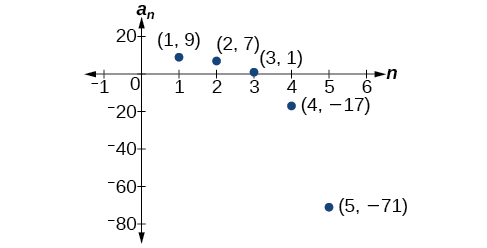
Write the first five terms of the sequence defined by the recursive formula.
**Given a recursive formula with two initial terms, write the first
terms of a sequence.**
which is given as part of the formula.
which is given as part of the formula.
term.
Write the first six terms of the sequence defined by the recursive formula.
The first two terms are given. For each subsequent term, we replace
and
with the values of the two preceding terms.
The first six terms are
See [link].
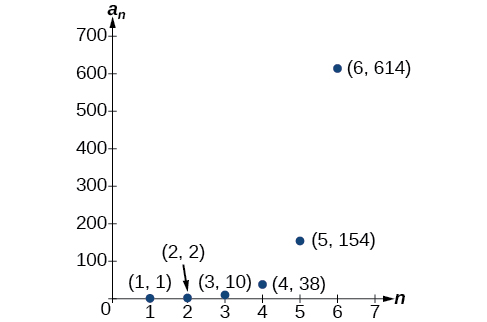
Write the first 8 terms of the sequence defined by the recursive formula.
The formulas for some sequences include products of consecutive positive integers.
</math> factorial</strong>, written as
is the product of the positive integers from 1 to
For example,
An example of formula containing a factorial is
The sixth term of the sequence can be found by substituting 6 for
The factorial of any whole number
is
We can therefore also think of
as
n factorial is a mathematical operation that can be defined using a recursive formula. The factorial of
denoted
is defined for a positive integer
as:
The special case
is defined as
Can factorials always be found using a calculator?
No. Factorials get large very quickly—faster than even exponential functions! When the output gets too large for the calculator, it will not be able to calculate the factorial.
Write the first five terms of the sequence defined by the explicit formula
Substitute
and so on in the formula.
The first five terms are
[link] shows the graph of the sequence. Notice that, since factorials grow very quickly, the presence of the factorial term in the denominator results in the denominator becoming much larger than the numerator as
increases. This means the quotient gets smaller and, as the plot of the terms shows, the terms are decreasing and nearing zero.
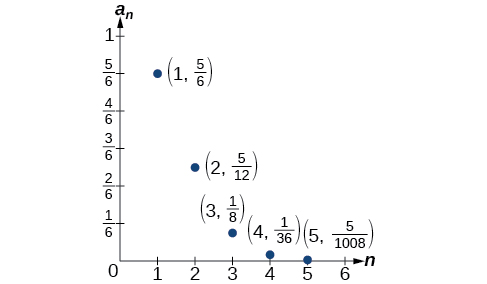
Write the first five terms of the sequence defined by the explicit formula
The first five terms are
Access this online resource for additional instruction and practice with sequences.
| Formula for a factorial |
term of a sequence can be written by analyzing the pattern of several terms. See [link].
is the product of all integers from 1 to
See [link].
Discuss the meaning of a sequence. If a finite sequence is defined by a formula, what is its domain? What about an infinite sequence?
A sequence is an ordered list of numbers that can be either finite or infinite in number. When a finite sequence is defined by a formula, its domain is a subset of the non-negative integers. When an infinite sequence is defined by a formula, its domain is all positive or all non-negative integers.
Describe three ways that a sequence can be defined.
Is the ordered set of even numbers an infinite sequence? What about the ordered set of odd numbers? Explain why or why not.
Yes, both sets go on indefinitely, so they are both infinite sequences.
What happens to the terms
of a sequence when there is a negative factor in the formula that is raised to a power that includes
What is the term used to describe this phenomenon?
What is a factorial, and how is it denoted? Use an example to illustrate how factorial notation can be beneficial.
A factorial is the product of a positive integer and all the positive integers below it. An exclamation point is used to indicate the operation. Answers may vary. An example of the benefit of using factorial notation is when indicating the product It is much easier to write than it is to write out
For the following exercises, write the first four terms of the sequence.
First four terms:
First four terms:
.
First four terms:
.
First four terms:
.
First four terms:
For the following exercises, write the first eight terms of the piecewise sequence.
For the following exercises, write an explicit formula for each sequence.
For the following exercises, write the first five terms of the sequence.
First five terms:
First five terms:
For the following exercises, write the first eight terms of the sequence.
For the following exercises, write a recursive formula for each sequence.
For the following exercises, evaluate the factorial.
For the following exercises, write the first four terms of the sequence.
First four terms:
First four terms:
For the following exercises, graph the first five terms of the indicated sequence
For the following exercises, write an explicit formula for the sequence using the first five points shown on the graph.
For the following exercises, write a recursive formula for the sequence using the first five points shown on the graph.
Follow these steps to evaluate a sequence defined recursively using a graphing calculator:
and press [ENTER].
Press [ENTER].
For the following exercises, use the steps above to find the indicated term or terms for the sequence.
Find the first five terms of the sequence
Use the >Frac feature to give fractional results.
First five terms:
Find the 15th term of the sequence
Find the first five terms of the sequence
First five terms:
Find the first ten terms of the sequence
Find the tenth term of the sequence
Follow these steps to evaluate a finite sequence defined by an explicit formula. Using a TI-84, do the following.
button for
that begins the sequence.
that ends the sequence.
Using a TI-83, do the following.
For the following exercises, use the steps above to find the indicated terms for the sequence. Round to the nearest thousandth when necessary.
List the first five terms of the sequence
List the first six terms of the sequence
First six terms:
List the first five terms of the sequence
List the first four terms of the sequence
First four terms:
List the first six terms of the sequence
Consider the sequence defined by
Is
a term in the sequence? Verify the result.
If
is a term in the sequence, then solving the equation
for
will yield a non-negative integer. However, if
then
so
is not a term in the sequence.
What term in the sequence
has the value
Verify the result.
Find a recursive formula for the sequence
(Hint: find a pattern for
based on the first two terms.)
Calculate the first eight terms of the sequences
and
and then make a conjecture about the relationship between these two sequences.
Prove the conjecture made in the preceding exercise.
for some positive integer

You can also download for free at http://cnx.org/contents/fd53eae1-fa23-47c7-bb1b-972349835c3c@8.1
Attribution: